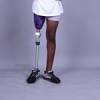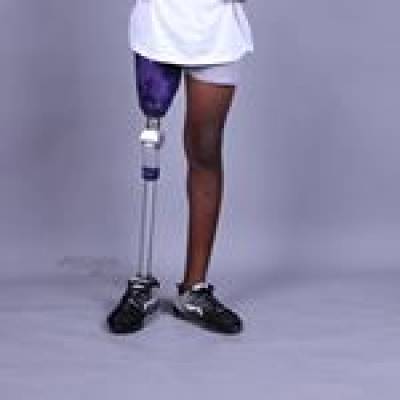Once you’ve healed from surgery and are ready to begin your journey as a new amputee, you’ll be fitted with a prosthesis, or prosthetic limb, to replace the surgically removed one. While your prosthetist will be able to guide you on how to use, care for, and maintain your new limb, it's also important that you learn how to care for it each and every day, and carry out a few important steps to be sure that your prosthetic limb lasts as long as possible.
What is a Prosthesis?
First off - what's a prosthesis? The definition of a prosthesis in the medical world is an artificial device that replaces a missing body part. A prosthesis is also known as an artificial limb, and is an externally applied device that is designed to make the loss of a limb less drastic for everyday life. Typically, body parts can be lost through trauma, through surgery because of a variety of diseases, or because of birth defects.
There are a variety of prostheses that are available to amputees. Passive prostheses are generally considered to be devices that are worn purely for cosmetic purposes. Functional prostheses, on the other hand, are devices that enable an amputee to perform tasks. These devices may or may not also serve a cosmetic purpose. Learn more about prosthetics in our blog post[https://purpleprosthetics.com/blog]
Caring for your Prosthetic Limb
Using your prosthetic limb correctly, as well as cleaning it and keeping it maintained regularly, will help it last much longer. To keep your residual limb healthy, as well as avoid costly replacement expenses, there are a few steps that you can follow. Knowing how to care for your new prosthesis, or one that you’ve had for a while, will help keep your prosthetic limb in tip-top shape, as well as make you aware of any signs of damage that could be fixed early to avoid replacing it entirely.
Here are some ways to be sure that your prosthetic limb lasts for as long as possible.
Use Your Prosthesis Under Normal Conditions
Most prosthetic limbs aren’t designed for high-impact sports or activities. These types of prosthetics are usually custom-built according to the level of physical activity that the patient plans to engage in.
Most prostheses are not intended to be used in water. Do not put your prosthetic limb into water unless it's designed for swimming.
Avoid using chemicals that could alter or damage the materials of the prosthetic limb.
Clean Your Socket Daily
The socket is the most critical component of your prosthesis. If it doesn't fit correctly, you can experience pain, sores and blisters, and the prosthesis will feel heavy and cumbersome.
Dirty sockets, socks and liners can harbor bacteria, causing odor and skin problems, such as a rash, fungus and redness.
To clean the socket, use mild soap and a soft, clean sponge or cloth.
Dry the inside with a soft, clean, dry towel, and leave it to dry overnight.
The socket will also need to be disinfected at the end of each day to minimize bacteria. Simply using rubbing alcohol is usually sufficient.
Clean Socks, Liners, and Shrinker Socks
Since the liner touches your skin all day, you will need to clean it on a daily basis.
Change your socks daily to avoid infection or fungus build-up from daily use.
Wash the socks by hand with lukewarm water and mild soap.
Do not use detergent, and be sure that all of the soap is rinsed clean from the sock - otherwise the skin may become irritated.
Other Cleaning Tips
Keep leather pieces dry and clean at all times, and try using saddle soap if cleaning is necessary.
Consult your prosthetist for tips on caring for the mechanical parts of your prosthetic limb.
Be sure that you meet with them for regular checkups of the mechanical portions of your limb.
Report loud or grating noises to your prosthetist.
Don’t adjust any mechanical parts or important components yourself.
Report damaged cables or damaged areas of your limb to your prosthetist.
Store your prosthetic limb in a horizontal position, laying flat.
You can sprinkle baking soda on your residual limb to avoid the bacteria and odors to the prosthetic limb that sweating can cause.
Examine your residual limb every day. Any redness or pain should be reported to your doctor because this chaffing or wear can usually be corrected with simple adjustments to the prosthetic limb.
Hygiene
Clean skin is a necessity for prosthetic limb wearers. Many prosthetic limbs can trap heat and perspiration, causing bacteria to build up and grow. These bacteria, if left in the prosthesis, can cause skin irritations and, down the line, they can even cause abrasions.
For information about residual limb hygiene, please view our blog post here. [https://purpleprosthetics.com/blog/]
Remember...
Recovery is an ongoing process, and varies from person to person. There are several phases on the road to recovery, and each can hold difficult challenges and require different coping strategies. Many people feel that talking with friends and family (or a counselor) can help ease emotional distress.
Whether you are an elderly patient who lives a less active life requiring a basic set-up or a young, active athlete sprinting on a Cheetah blade; or an individual requiring a high tech prosthesis, The highly qualified staff of Purple Prosthetics[https://purpleprosthetics.com/] will select, design, and fabricate the appropriate prostheses, prosthetic limb or device, or orthosis to fit your specific lifestyle and needs after your amputation. call us 08065541404 to book a free consultation at our facility and we can help you get moving again with a prosthesis designed for you after your amputation!

